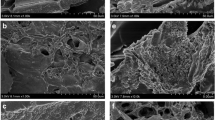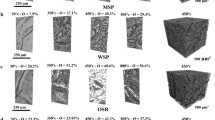Abstract
Purpose
The combination of analytical chemistry and simulation methods provides more complete information about biochars.
Materials and methods
The biochars prepared by pyrolysis of the crop straw at 300 and 500 °C were investigated by elemental analysis, pyrolysis-gas chromatography-mass spectrometry (Py-GC-MS) and solid-state 13C nuclear magnetic resonance (NMR) spectrometry to build the 2D structural models of biochars. The most stable and balanced 3D conformations were gained by optimizing in the optimized potential for liquid simulation (OPLS) force field of molecular mechanic and molecular dynamic simulation of HyperChem® software.
Results and discussion
There were few O-containing and N-containing compounds in biochars. According to the results of Py-GC-MS, 41 and 28 pyrolysis products were identified for the building of the conceptual models of 300 and 500 °C biochars. Solid-state 13C NMR data also demonstrated that there were very high values of unsaturated C in biochars. The agreement between elemental concentration and chemical functional groups of two simulated models and experimental biochars was successfully achieved. Quantitative structure activity relationship (QSAR) properties were calculated and indicated the correlation of molecular structures with properties such as surface area, volume, polarizability, refractivity, and hydration energy.
Conclusions
The conceptual structural models of corn straw biochars produced at 300 and 500 °C were C78H68N2O25 and C59H29NO10, respectively. The simulation results showed that the 3D structure of the 300 °C biochar with −4 charges and the nonprotonated 3D structure of the 500 °C biochar were the most stable. Deprotonation reaction is an endothermic process.






Similar content being viewed by others
References
Asai H, Samson BK, Stephan HM, Songyikhangsuthor K, Homma K, Kigono Y, Inone Y, Shiraiwa T, Horie T (2009) Biochar amendment techniques for upland rice production in Northern Laos. 1. Soil physical properties, leaf SPAD and grain yield. Field Crop Res 111(1-2):81–84
Baldock JA, Skjemstad JO (2000) Role of the soil matrix and minerals in protecting natural organic materials against biological attack. Org Geochem 31(7):697–710
Carvalho AM, Bustamante MMC, Alcântara FA, Resck IS, Lemos SS (2009) Characterization by solid-state CPMAS 13C NMR spectroscopy of decomposing plant residues in conventional and no-tillage systems in Central Brazil. Soil Till Res 102:144–150
Chen B, Chen Z (2009) Sorption of naphthalene and 1-naphthol by biochars of orange peels with different pyrolytic temperatures. Chemosphere 76:127–133
Chen JS, Chiu CY (2003) Characterization of soil organic matter in different particle-size fractions in humid subalpine soils by CP/MAS 13C NMR. Geoderma 117:129–141
Chen B, Zhou D, Zhu L (2008) Transitional adsorption and partition of nonpolar and polar aromatic contaminants by biochars of pine needles with different pyrolytic temperatures. Environ Sci Technol 42(14):5137–5143
Day D, Evans RJ, Lee JW, Reicosky D (2004) Valuable and stable co-product from fossil fuel exhaust scrubbing. Am Chem Soc Div Fuel Chem 49(2):802–804
de la Rosa JM, González-Pérez JA, González-Vila FJ, Knicker H, Araújo MF (2011) Molecular composition of sedimentary humic acids from South West Iberian Peninsula. A multi-proxy approach. Org Geochem 42(7):791–802
Elad Y, David DR, Harel YM, Borenshtein M, Kalifa HB, Silber A, Graber ER (2010) Induction of systemic resistance in plants by biochar, a soil-applied carbon sequestering agent. Phytopathology 100:913–921
Glaser B, Lehmann J, Zech W (2002) Ameliorating physical and chemical properties of highly weathered soils in the tropics with charcoal—a review. Biol Ferti Soils 35(4):219–230
González-Vila FJ, Lüdemann HD, Martín F (1983) 13C NMR structural features of soil humic acids and their methylated, hydrolyzed and extracted derivatives. Geoderma 31:3–15
Lan HN, Wang YX, Zheng MZ, Han WW, Zheng X (2013) Using homology modeling, molecular dynamics and molecular docking techniques to identify inhibitor binding regions of somatostatin receptor 1. Chem Res Chin Univ 29(1):139–143
Lehmann J, da Silva Jr JP, Steiner C, Nehls T, Zech W, Glaser B (2003) Nutrient availability and leaching in an archaeological Anthrosol and a Ferralsol of the Central Amazon Basin: fertilizer, manure and charcoal amendments. Plant Soil 249(2):343–357
Li GJ (2009) Structural modeling of grassland chestnut soil humic acids through experimental characterization and molecular simulation. Dissertation, China Agricultural University
Mao F (2007) Separation of anthracene, phenanthrene and carbazole with solvent methods. Dissertation, Yangzhou University
Purevsuren B, Avid B, Tesche B, Davaajav YA (2003) A biochar from casein and its properties. J Mater Sci 38(11):2347–2351
Schulten HR (1995) The three-dimensional structure of soil organo-mineral complexes studied by analytical pyrolysis. J Anal Appl Pyrol 32:111–126
Schulten HR (1996) Characterization of humic and soil particles by analytical pyrolysis and computer modeling. J Anal Appl Pyrol 38(1-2):1–53
Schulten HR, Leinweber P (2000) New insights into organic-mineral particles: composition, properties and models of molecular structure. Biol Fertil Soils 30:399–432
Tinoco P, Almendros G, González-Vila FJ, Lankes U, Lüdemann HD (2004) Analysis of carbon and nitrogen forms in soil fractions after the addition of 15N-compost by 13C and 15N nuclear magnetic resonance. J Agric Food Chem 52:5412–5417
Xu X, Luo YF, Xiang YC (2004) Study on quantitative relationships between electronic structure and toxicities of phenyl-aldehydes and nitrogen-containing aromatic molecules. J Hygiene Res 33(1):105–107
Yarkova TA, Gyul’maliev AM (2012) Average structural model of humic acids of peat origin. Soil Fuel Chem 46(5):279–281
Zhao N, Lv YZ, Li GJ (2013) Characterization and three-dimensional structural modeling of humic acid via molecular mechanics and molecular dynamic simulation. Chem Res Chin Univ 29(6):1180–1184
Acknowledgments
This research was supported by the National Natural Science Foundation of China (41271331).
Author information
Authors and Affiliations
Corresponding author
Additional information
Responsible editor: Yu Luo
Rights and permissions
About this article
Cite this article
Zhao, N., Lv, Y. & Yang, X. A new 3D conceptual structure modeling of biochars by molecular mechanic and molecular dynamic simulation. J Soils Sediments 17, 641–655 (2017). https://doi.org/10.1007/s11368-015-1308-y
Received:
Accepted:
Published:
Issue Date:
DOI: https://doi.org/10.1007/s11368-015-1308-y




